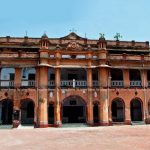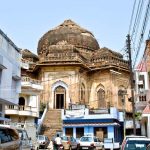Mehra Cinema
A Harbinger of Indian Cinema in Awadh
Not only of Lucknow but the very first theatre of Uttar Pradesh was constructed on Gwynne Road in Aminabad by the name of ‘Pearl Theatre’ in the year 1911. The Nawab of Utraula estate along with a few companions of his constructed it. In the initial days it was used by public for the purpose of a theatre instead of cinema hall, which was later on replaced by the projection of still photographs with a written caption and title along with every picture, which was displayed. As the time passed, even the projection of still photographs got replaced by the screening of silent movies. These movies were basically film with no synchronized recorded sound, especially with no spoken dialogue. In silent movies for entertainment the dialogues were transmitted through muted gestures, mime and title cards. It was during that phase that its name altered to ‘Kohinoor Theatre’ from Pearl Theatre. It was in the year 1918 that the theatre was sold to Radhakrishna Dhanpat Rai of Ludhiana, who again renamed it as ‘Royal Theatre’. It was during that phase that for approx. 20 years on time period silent movies were the only source of entertainment for the people which among which movies like, ‘Raja Harishchandra’, ‘Pundalik’, ‘Lanka Dahan’, ‘Kalia Mardan’, ‘Bhasmasur’, ‘Satyawan-Sawitri’ were the most famous and prominent one. In the year 1928, ‘Anarkali’, produced by Praful Rai made a record for screening and received countless appreciation.
From its lifespan of Pearl to Kohinoor and then to Royal theatre, or say in the later era of silent movies, songs were played along with these movies for the purpose of entertainment. In Royal theatre this task was accredited to Pioneer of Indian Music; Naushad Ali, who was one of the first and foremost composer in the history of Bollywood. He used to get paid Rs. 2 per day for the same in those days. It was in the year 1933 that the very first sound film ìAlam Araî was played in Royal theatre.
‘Alam Ara’ occupied its position in Indian film history as the first film to have employed sound and possess a diegetic soundtrack, complete with songs. A swashbuckling tale of warring queens, palace intrigue, jealousy and romance, the film was heavily drawn from Parsee theatre. The image and sound were recorded simultaneously in the Tanner single system camera. Since there was no recording studio of any kind in those days, the film often had to be shot behind closed doors and at night to avoid all extraneous sounds. Jyoti Studios, located near the French Bridge in Mumbai overlooking the railway tracks was the studio where ‘Alam Ara’ was shot. The crew could only shoot at night when the trains did not run, since parts of the studio rattled with the sounds of the passing trains. Microphones were placed around actors to pick up their dialogues in such a way that they were hidden from the camera, while instrumentalists climbed trees or hid behind them to provide invisible musical support. This first ever song was sung in this film by Wazir Mohammed Khan.
As by that time the silent movies were enlaced with sounds and voices, it was evident to see even the characters in the movies talk along with the actions they do, and therefore, almost all theatre’s names were changed to ‘Talkies’ instead of theatre as a postfix after their name. Thus, Royal theatre changed to ‘Royal Talkies’. In year 1934, Nitin Bose’s sound movie Chandi Das and V. Shantaram’s directed movie Sairandhari were screened here. Sairandhari was made in colour but for processing Shantaram took it to the UFO studios in Germany.
The story is about the twelfth of the thirteen years of the Pandavas exile. Draupadi in her identity as Sairandhari (female servant) is acting as the maid-in-waiting to Queen Sudeshna.
A rather famous occurrence that the theater carries is the appointment of a guard known as ‘Nawab’. He was even rumored to be a distant relative of the Nawabi lineage who, by the hands of fate, ended up as a mere watchman. A remarkable trait that Nawab showed was his staunch following of the Islamic faith. He used to take breaks from his duty for Namaz. During the month of Ramadan, he didn’t even go to the theatre, a place of revelry, to observe the mourning. Though his lineage has been a subject of rumors and gossips, his discipline has been an example.
‘Anarkali’, (sound movie) which was re-produced in direction of R.S.Chaudhary and Sohrab Modi’s movie ‘Pukaar’ (1935) were too screened here. In the very same year P.C.Barua’s directed movie ìDevdasî starring K.L.Sehgal (actor) and Jamuna (actress) infused several Devdas-like traits in the youth of the city when screened in this theatre. After the advent of talking films, songs and ghazals of Suraiya, K.L.Sehgal, Talat Mahmood and Begum Akhtar’s thumris and dadra became instant hits among the people of Lucknow. In the year 1986, the name of the theatre was changed from Royal talkies to ‘Mehra Talkies’, that remained open for public till the year 2011 when it was eventually shut down.
Kapil Pal
Writer is a student of Law and active Social Worker
(Published in The Lucknow Observer, Volume 2 Issue 14, Dated 05 May 2015)




